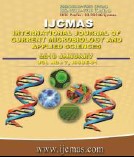


 National Academy of Agricultural Sciences (NAAS)
National Academy of Agricultural Sciences (NAAS)

|
PRINT ISSN : 2319-7692
Online ISSN : 2319-7706 Issues : 12 per year Publisher : Excellent Publishers Email : editorijcmas@gmail.com / submit@ijcmas.com Editor-in-chief: Dr.M.Prakash Index Copernicus ICV 2018: 95.39 NAAS RATING 2020: 5.38 |
A field experiment was conducted in Kharif season of 2014 at, J.N.K.V.V. College of Agriculture, Instructional Farm, Rewa (M.P.) under All India Coordinated Rice Improvement Project to study- “Integrated Weed Management in Aerobic Rice (Oryza sativa L.)”. The treatments comprised ten weed control methods which were laid out in randomized block design with three replications. Among the grassy weeds, Echinochloa species (annuals), Cynodon dactylon (perennials) and Cyperus rotundus (sedges) were the most dominating weeds. Among the broad-leaved weeds, Digeria arvensis, Anagalis arvensis, Launea asplanifolia, Euphorbia hirta, Eclipta alba, Phylanthus niruri and Celosia argentia (annuals) were the dominant weed species. The study reveals that weed control in aerobic rice by need based hand weeding (twice) treatment T9 appeared to be more effective for getting higher production. However, looking to the labour problem treatment T1 (Pendimethalin @ 1.00 kg a.i./ha + Bispyribac sodium @ 35 g.a.i/ha) and T5 (Butachlor @ 1.5 kg a.i./ha + Bispyribac sodium @ 35 g.a.i/ha) may be the best substitute of hand weeding twice from economic point of view. Among the weed control treatments, the need based hand weeding treatment (T9) and application of Butachlor (50EC) + Bispyribac sodium (10%SC) (T5) resulted in significantly higher grain yield of 5406.079 and 4946.93 kg/ha respectively. In aerobic rice, the WCE was recorded up to 92.44% in case of need based hand weeding treatment. Amongst the weed control treatments, application of Butachlor (50EC) + Bispyribac sodium (10%SC) (T5) treatment gave the maximum net income (Rs.56135/ha) and B: C ratio (3.45).
 |
 |
 |
 |
 |